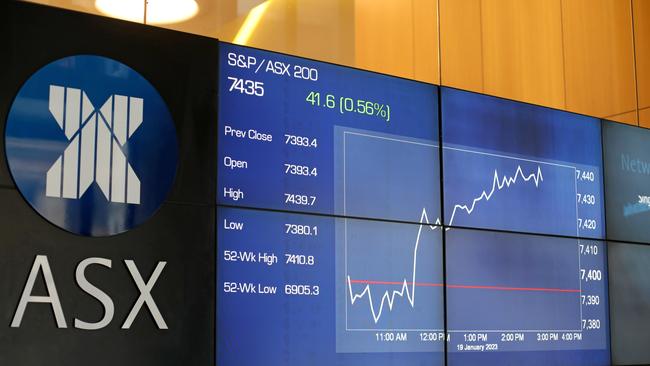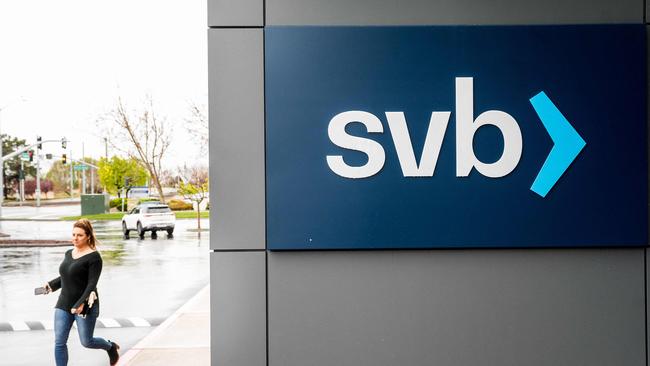Australian shares expected to be rattled and financial stocks lower
The Australian sharemarket is expected to open weaker Monday as local investors adjust risk premiums and dump financial stocks following the SVB failure.

Investor panic erupting from the collapse of Silicon Valley Bank on Friday, the 16th largest bank in the US, is expected to wash across the Australian sharemarket on Monday as local investors readjust their risk premiums and dump financial stocks to protect themselves and their equity portfolios from the fast-moving contagion.
Already on Friday in local trading there were some early tremors on the local market, with the big four banks - Commonwealth, ANZ, Westpac and National Australia Bank - plus Macquarie Bank sliding around 3 per cent and the selling is tipped to intensify at the opening bell this week.
Perpetual head of investment strategy Matt Sherwood said stress had been building up in the system for some time as interest rates quickly accelerated across the world and investors began to reassess their exposure to equities, and the collapse of SVB would likely heighten this nervousness sentiment.
“We saw the beginning stages of this last week. Markets could open weaker on Monday. There is obviously a lot of stress building in the financial system and central banks, none of them, outside the Bank of Canada, are actually at the end of their tightening cycle, so there is certainly stress building and there‘s more stress to come because interest rates are going up,” Mr Sherwood said.
“So it certainly could impact share prices initially, the direct flow through (from SVB) is almost non-existent, but the blowout in risk premiums is probably something that we will see across regions.”
He said tightening monetary policy “always breaks something” and we have now moved into that phase.
“Rates have gone up very aggressively and now it is starting to impact the fragile parts of the US economy.”

The SVB collapse on Friday, the second-biggest bank failure in US history and the largest since the global financial crisis in 2008, has been partly blamed on the aggressive uplift in interest rates by central banks led by the US Federal Reserve. Rising interest rates eroded the value of its long-term bonds, which saw SVB on Wednesday forced to sell $US21bn worth of bonds at a loss of $US1.8bn.
“What starts out in America does have potential wider ramifications because it leads to a blow out in risk premium and people are now worried about stresses in the global financial system, the impact of the rapid rise in interest rates and the massive sell off in bonds can actually have on bank balance sheets,” said Mr Sherwood.
AMP chief economist and head of investment strategy Shane Oliver said at this stage it was too early to tell if problems at SVB reflect just isolated problems or were indicative of wider potential problems impacting the US banking system.
“Either way banks are likely to see a tougher environment ahead as growth slows and higher rates cause more financial stress for borrowers. And it is a sign that Fed tightening has got traction and the Fed may be close to the top on rates,” Mr Oliver said.
“The year ahead is likely to see easing inflation pressures, central banks moving to get off the brakes and economic growth weakening but stronger than feared. This along with improved valuations should make for better returns than in 2022. But there will be bumps on the way – particularly regarding interest rates, recession risks, geopolitical risks and raising the US debt ceiling in the September quarter.”
In terms of economic news this week that investors will be keeping an eye on, the latest Westpac-Melbourne Institute Consumer Sentiment figures will be released on Tuesday are expected to show the string of interest rate rises has kept the consumer in a highly pessimistic mood.
“Consumer confidence for March might improve slightly following less hawkish RBA commentary but its likely to remain around recessionary levels,” said Mr Oliver.
March inflation expectations released on Thursday will be keenly awaited by investors too as the RBA is showing that inflationary expectations are playing a more important role in its decision making on rates. On the same day February unemployment figures will be released with Westpac economists and analysts tipping employment to grow by 50,000, and an expectation that the participation will hold flat at 66.5 per cent. The unemployment rate is tipped to edge lower, from 3.7 per cent to 3.6 per cent.




To join the conversation, please log in. Don't have an account? Register
Join the conversation, you are commenting as Logout